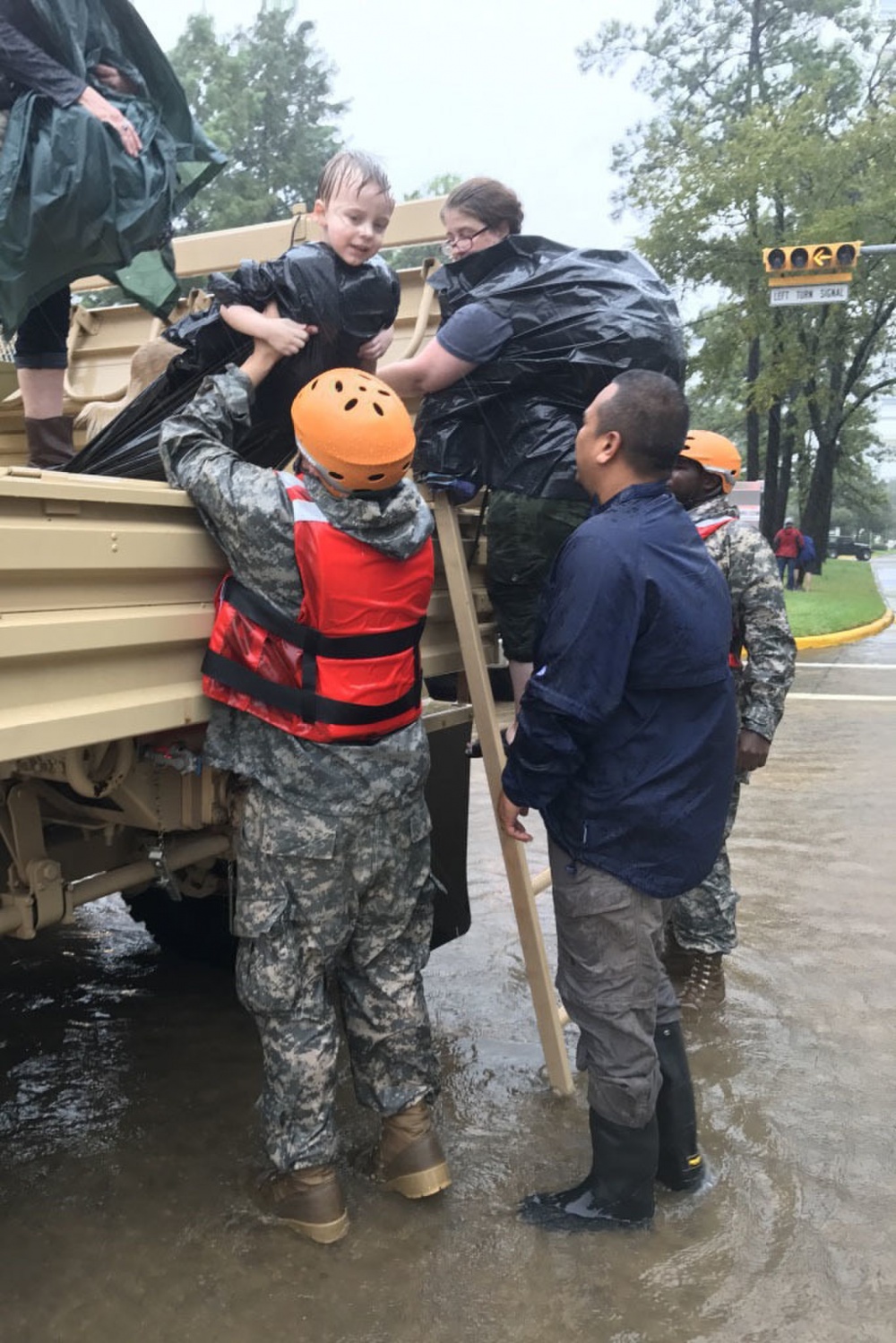Story by: Capt. Martha Nigrelle
 Texas Guardsmen from the 386th Engineer Battalion and a local volunteer help residents down from a military vehicle in Cypress Creek, Texas, August 29, 2017. The Texas National Guard partnered with first responders from Texas Task Force One and the Cypress Creek Fire Department to move residents from severely flooded neighborhoods to safety days after Hurricane Harvey hit south Texas. (U.S. Army National Guard photo by Capt. Martha Nigrelle)
Texas Guardsmen from the 386th Engineer Battalion and a local volunteer help residents down from a military vehicle in Cypress Creek, Texas, August 29, 2017. The Texas National Guard partnered with first responders from Texas Task Force One and the Cypress Creek Fire Department to move residents from severely flooded neighborhoods to safety days after Hurricane Harvey hit south Texas. (U.S. Army National Guard photo by Capt. Martha Nigrelle)
CYPRESS CREEK, Texas – Texas National Guardsmen from the 386th Engineer Battalion teamed up with Texas Task Force 1 and the Cypress Creek Fire Department, bringing 1,000 Cypress Creek residents from high-rising waters to safety, just days after Hurricane Harvey hit Texas shores, August 28, 2016.
As heavy rains fell over the city, water levels continued to rise to dangerous and historic levels – some areas seeing more than five feet of flooding.
The flooding appeared to be the worst in a handful of sub-divisions.
“Today was a day no one ever thought they’d see,” said Pfc. Adelisa Fuentes, 386th Engineer Battalion. “There was water rising up to your hips and the further the road went, the deeper the flood was.”
Texas Guardsmen equipped with swift-water vehicles and their partners, equipped with boats set out to help the many people in danger.
Swift water vehicles can safely move through approximately 30 inches of water. Texas Guardsmen took their trucks as far as they could before dismounting Task Force boats.
First responders used boats to go through entire neighborhoods, bringing all those in danger to safety.
“This is what we train for,” said Texas Army National Guard Brig. Gen. Patrick M. Hamilton, Dual Status Commander for Hurricane Harvey Recovery Efforts. “And we’re proud to stand beside our civilian partners, first responders and volunteers to serve the citizens of Texas.”
It isn’t uncommon to find National Guardsmen working or training alongside emergency first responders – it’s a part of their mission.
Texas Guardsmen train year-round with partner first responders like Texas Task Force One, so that when a disaster occurs in Texas, they are prepared.
“This is Texans helping Texans – neighbors helping neighbors,” Hamilton said. “While we don’t want to have to put our training to the test during a tragedy, our citizen-guardsmen remain prepared to help save lives and property, when called.”
The team of Soldiers and first responders took on a new dynamic in the wake of Hurricane Harvey as local residents stopped to help.
Those owning boats or jet skis, used them to assist in transporting victims to safety. Others brought water and helped transfer people and equipment onto the National Guard vehicles.
“Watching others bring victims to safety into our LMTVs showed how much heart people really have and that they don’t just depend on us to do the work alone,” said Fuentes. “All help is worth a hand in a time of need.”
One man even cooked a platter of chicken, wading into water three feet deep in order to feed both Soldiers and volunteers – a much welcomed surprise as most appeared to work through lunch without stopping.
Dogs, cats and even a lucky stuffed iguana were passed from boats to Soldiers, followed by their owners and the residents of the neighborhoods suffering from severe flooding.
Emotions were varied, some were in high spirits while others seemed overwhelmed by their new reality.
One woman had spent the previous day as an EMT rescuing people all over the city from flooding.
“You never think you’re going to be the victim,” she said. “Thank you. From the bottom of my heart, thank you.”
After six hours of wading through deep waters, Soldiers and partner first responders, ensuring everyone who needed help was safe, began to pack up.
Despite the long hours and poor weather conditions, the Soldiers all appeared to be energized, focused and in good spirits.
“Nothing is more important to our Guardsmen than the chance to serve their local community.” Hamilton said. “Helping our neighbors when they need us most is the heart of The Guard, and why we choose to become Citizen Soldiers and Airmen.”
One Texas Guardsman on scene, felt the same way.
“I am so glad I was able to be there to help my fellow Texans get to safety from their flooded homes,” said Fuentes. “It’s heartbreaking, but everyone is safe.”